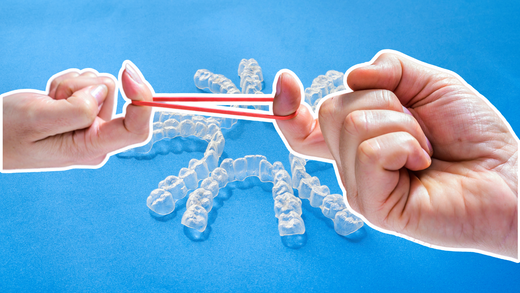5 stars reviews from dentists all around the world! ★ ★ ★ ★ ★
Recent Post
Archive
- October 2025
- July 2025
- January 2025
- November 2024
- September 2024

Using clear aligners and elastics: a great combination!
Stephane Reinhardt
Since the introduction of elastics in orthodontics by Calvin Case in 1892, they have proven to be a valuable tool for achieving effective tooth movement. With the rising popularity of clear aligners and their integration into comprehensive treatment planning by general dentists, the question arises: Can we use elastics with clear aligners? The answer is a resounding yes! Let's explore why elastics are beneficial when used with clear aligners and how to incorporate them effectively.
Clear aligners have revolutionized orthodontic treatment, providing patients with a discreet and comfortable alternative to traditional braces. However, there are certain tooth movements and cases that can benefit from the additional forces generated by elastics. Elastics produce light continuous forces when stretched, making them ideal for achieving various orthodontic goals. Incorporating elastics with clear aligners allows dentists to enhance their treatment plans and achieve optimal results.

When using elastics with clear aligners, the principles remain similar to those with traditional braces. Elastics can be employed to facilitate anterior-posterior correction, distalization, space closure, extrusion and intrusion, rotation, traction, and midline correction. They become a versatile tool in the orthodontic toolbox, providing additional forces to guide tooth movement effectively.
To ensure the desired results, it's important to understand the composition and classification of elastics. Manufacturers offer a range of intraoral elastics in different sizes and forces. The force of an elastic is typically measured in ounces and can range from 2oz to 8oz, depending on the desired effect. Light, medium, and heavy force elastics are available, with the thickness of the elastic determining the tension it creates when stretched. While the empirical rule of 3 suggests that stretching an elastic to 3 times its inner diameter results in the specified force, it is advisable to use instruments like Dontrix or Corex for accurate force measurement.

The versatility of clear aligners is further enhanced by their compatibility with elastics. Two basic methods can be employed: hooks or cutbacks. In the ClinCheck Pro software used with Invisalign clear aligners, dentists can choose between these options to plan the use of elastics. Hooks enable direct attachment of the elastics to the aligner, allowing forces to be transferred across the entire arch. Cutbacks, on the other hand, facilitate bonding buttons on specific teeth for elastic use.

Choosing between hooks and cutbacks depends on the desired treatment goals. If the focus is on jaw movement alone, hooks directly attached to the aligner are suitable. However, if both jaw and tooth movement are desired, buttons bonded to the teeth provide better control. In cases where the elastics were not initially planned in the ClinCheck, additional hooks or cutouts can be added using specialized pliers or scissors.
When using hooks, it's crucial to consider anchorage. The force generated by the elastics will attempt to dislodge the aligner, so providing anchorage on the teeth where the elastics are attached is essential. A rectangular attachment perpendicular to the line of force of the elastic is recommended to ensure stability. With bonded buttons, anchorage is not an issue, and the position of the button can be adjusted mesially or distally to achieve the desired effect on the tooth.

Incorporating elastics with clear aligners enables dentists to provide specialized care and address more complex cases. By understanding when and how to use elastics correctly, optimal outcomes can be achieved while maintaining the comfortable and aesthetic advantages of clear aligner treatment. Remember, a solid diagnostic and treatment planning foundation is key to success in any orthodontic treatment or dental procedure.
If you are a dentist interested in learning more about using elastics with clear aligners, we invite you to register for The CLEAR Institute's online course, "How to Use Elastics with Clear Aligners." This course provides comprehensive insights and practical techniques to further enhance your orthodontic skills. For those seeking an even deeper understanding of clear aligner treatment, consider enrolling in the Master Of Clear Aligners (MOCA) online learning programs, which delves into the complete concepts, principles and strategies to integrate clear aligners successfully in your practice.
Elevate your orthodontic practice and achieve exceptional results by harnessing the power of elastics in conjunction with clear aligners.
And as always, have fun Making the MOVE!
You want to know more about how to use elastics and clear aligners? Register to our online course "How to use elastics with clear aligners" HERE
You can also watch our YouTube video on The CLEAR Institute's channel (and if you are not subscribes yet, it's the right time to do it!):
👉 Feel free to share this article with colleagues or peers who might find it intriguing.
Let’s stay at the forefront of advancements in clear aligner technology together!
Register for our courses today and embark on a transformative learning journey with The CLEAR Institute.
You want information on our courses, programs, and services? Book some private time with Dr. Stephane Reinhardt 👉 HERE 👈
You need help with your treatment planning, go 👉 HERE 👈
You need help with your cases, and you want personalized one-on-one private coaching? Book some private time with Dr. Stephane Reinhardt 👉 HERE 👈
Take your practice to the next level with our personalized 2-day in-office coaching—tailored for you and your team to master clear aligner integration together. 👉 HERE 👈
To learn more about our online and in-person training, here are the direct links:
✅ Online courses: https://bit.ly/CLEAR_online
✅ LIVE In-person classes: https://bit.ly/CLEAR_live
✅ MOCA programs: https://bit.ly/learning_programs
✅ YouTube channel: https://bit.ly/YTCLEARsubscribe
← Older Post Newer Post →




